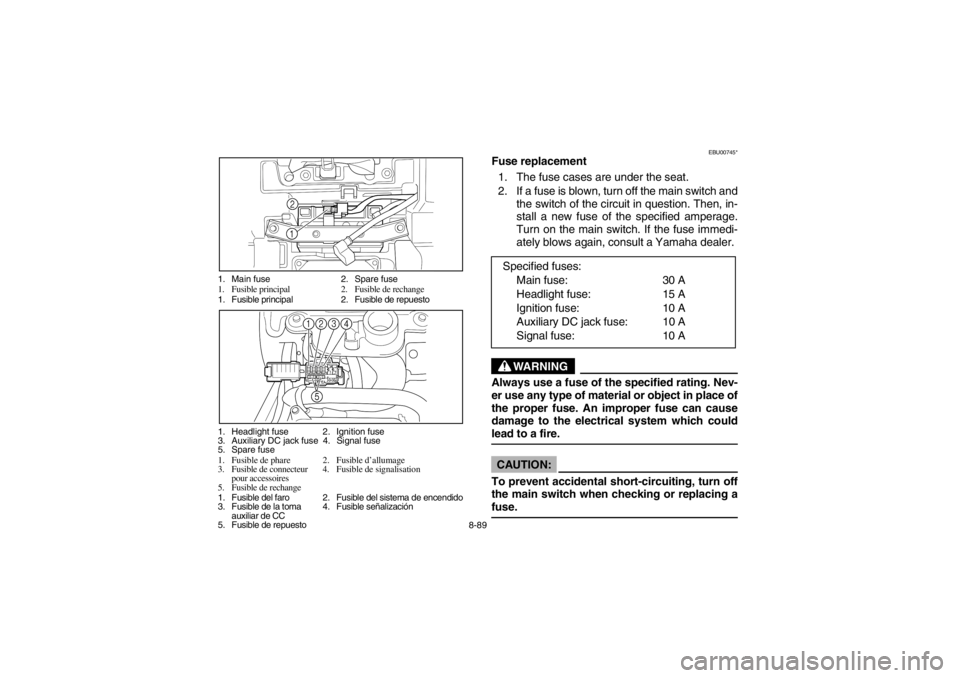Page 48 of 388
2-15
WARNING
�
Always turn off the engine when refueling.
�
Do not refuel right after the engine has
been running and is still very hot.
�
Do not spill gasoline on the engine or ex-
haust pipe/muffler when refueling. Never
refuel while smoking, or while in the vicini-
ty of sparks, open flames, or other sources
of ignition such as the pilot lights of water
heaters and clothes dryers. Gasoline can
catch fire and you could be burned.
�
When transporting the machine in another
vehicle, be sure it is kept upright and that
the fuel cock is in the “OFF” position. Oth-
erwise, fuel may leak out of the carburetor
or fuel tank.
�
Gasoline is poisonous. If you should swal-
low some gasoline or inhale a lot of gaso-
line vapor, or get some gasoline in your
eyes, see your doctor immediately. If gaso-
line spills on your skin, wash with soap
and water. If gasoline spills on your cloth-
ing, change your clothes.
EE.book Page 15 Monday, June 18, 2001 10:18 AM
Page 338 of 388
8-85
WARNING
Battery electrolyte is poisonous and danger-
ous, causing severe burns, etc. It contains sul-
furic acid. Avoid contact with skin, eyes or
clothing.
Antidote:�
EXTERNAL: Flush with water.
�
INTERNAL: Drink large quantities of water
or milk. Follow with milk of magnesia, beat-
en egg or vegetable oil. Call a physician
immediately.
�
EYES: Flush with water for 15 minutes and
get prompt medical attention.
Batteries produce explosive gases. Keep
sparks, flame, cigarettes or other sources of
ignition away. Ventilate when charging or us-
ing in an enclosed space. Always shield your
eyes when working near batteries.
KEEP OUT OF REACH OF CHILDREN.
EE.book Page 85 Monday, June 18, 2001 10:18 AM
Page 342 of 388

8-89 1. Main fuse 2. Spare fuse
1. Fusible principal 2. Fusible de rechange
1. Fusible principal 2. Fusible de repuesto
1. Headlight fuse 2. Ignition fuse
3. Auxiliary DC jack fuse 4. Signal fuse
5. Spare fuse
1. Fusible de phare 2. Fusible d’allumage
3. Fusible de connecteur 4. Fusible de signalisation
pour accessoires
5. Fusible de rechange
1. Fusible del faro 2. Fusible del sistema de encendido
3. Fusible de la toma 4. Fusible señalización
auxiliar de CC
5. Fusible de repuesto
EBU00745*
Fuse replacement
1. The fuse cases are under the seat.
2. If a fuse is blown, turn off the main switch and
the switch of the circuit in question. Then, in-
stall a new fuse of the specified amperage.
Turn on the main switch. If the fuse immedi-
ately blows again, consult a Yamaha dealer.
WARNING
_ Always use a fuse of the specified rating. Nev-
er use any type of material or object in place of
the proper fuse. An improper fuse can cause
damage to the electrical system which could
lead to a fire. _CAUTION:_ To prevent accidental short-circuiting, turn off
the main switch when checking or replacing a
fuse. _
Specified fuses:
Main fuse: 30 A
Headlight fuse: 15 A
Ignition fuse: 10 A
Auxiliary DC jack fuse: 10 A
Signal fuse: 10 A
EE.book Page 89 Monday, June 18, 2001 10:18 AM
Page 350 of 388

8-97
EBU00413
Troubleshooting
Although Yamaha machines receive a rigid in-
spection before shipment from the factory, trouble
may occur during operation.
Any problem in the fuel, compression, or ignition
systems can cause poor starting and loss of pow-
er. The troubleshooting chart describes a quick,
easy procedure for making checks. If your ma-
chine requires any repair, take it to a Yamaha
dealer.
The skilled technicians at a Yamaha dealership
have the tools, experience, and know-how to prop-
erly service your machine. Use only genuine
Yamaha parts on your machine. Imitation parts
may look like Yamaha parts, but they are often in-
ferior. Consequently, they have a shorter service
life and can lead to expensive repair bills.
WARNING
Do not smoke when checking the fuel system.
Fuel can ignite or explode, causing severe in-
jury or property damage. Make sure there are
no open flames or sparks in the area, including
pilot lights from water heaters or furnaces.
EE.book Page 97 Monday, June 18, 2001 10:18 AM
Page 352 of 388
8-99
EBU00440Troubleshooting chart1. Fuel
Check if there is fuel
in the fuel tank.There is fuel.Turn the fuel
cock to “OFF”.Remove the fuel pipe
from the fuel cock. Fuel cock
clogged.
Clean fuel
cock. Some fuel.Turn the fuel
cock to “RES”.Restart engine.
No fuel.
Supply fuel
2. Compression
Use electric starter
to see if there is
compression.There is compression.
No compression.
3. Ignition
Remove plug and
check electrodes.WetWipe clean with
dry cloth.
DryAttach plug cap and
ground to chassis.Use the
electric starter.Spark good.Ignition system
normal.
Spark weak.
Adjust plug gap
or replace plug. No spark.
Ask a Yamaha dealer to inspect. 4. Battery
Use electric starter.Engine turns over
quickly.Battery good.
Engine turns over
slowly.
Check fuel
flow. Turn the fuel
cock to “ON”.
Compression normal.Ask a Yamaha dealer to inspect.
Recharge, check
connections.
No fuel.
EE.book Page 99 Monday, June 18, 2001 10:18 AM
Page 371 of 388
10-6
Suspension:
Front suspension Double wishbone
Rear suspension Swingarm (monocross)
Shock absorber:
Front shock absorber Coil spring / Oil damper
Rear shock absorber Coil spring / Oil damper
Wheel travel:
Front wheel travel 100 mm
Rear wheel travel 110 mm
Electrical:
Ignition system D.C. C.D.I.
Generator system A.C. magneto
Battery type YTX 20L-BS
Battery voltage, capacity 12 V, 18 AH
Headlight type: Bulb type
Bulb voltage, wattage
× quantity:
Headlight 12 V, 30 W / 30 W
× 2
Tail / brake light 12 V, 5 W / 21 W × 1
Meter light 12 V, 3 W
× 1
Indicator light:
Neutral 12 V, 1.7 W
× 1
Reverse 12 V, 1.7 W × 1
Oil temperature 12 V, 1.7 W
× 1 Model YFM400FP/YFM400FW
EE.book Page 6 Monday, June 18, 2001 10:18 AM